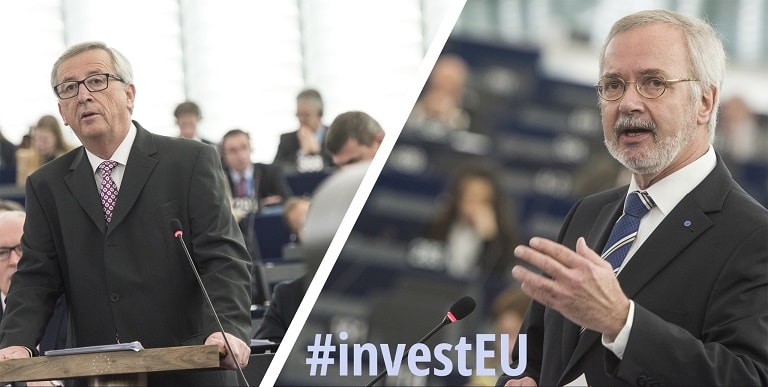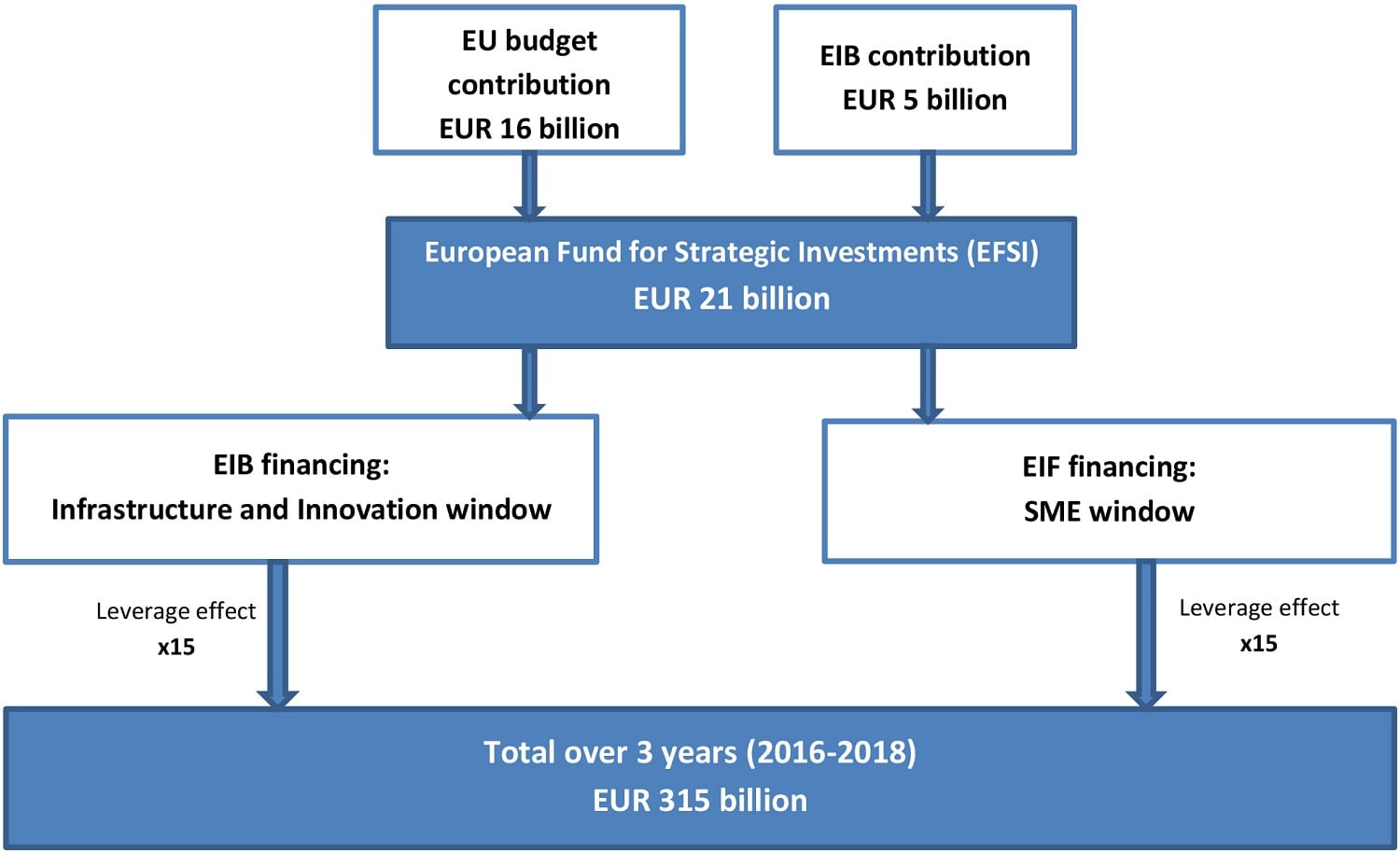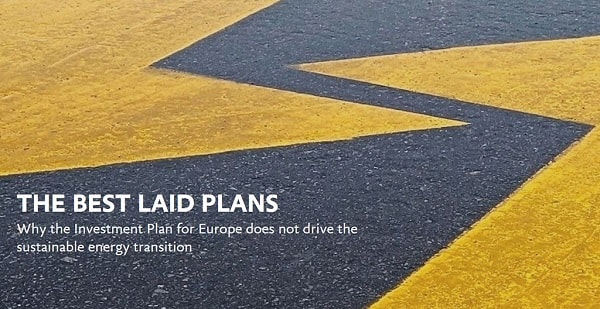European Fund for Strategic Investments (EFSI)
Tasked with stimulating the European economy, the new investment fund may just become an extention of the European Investment Bank’s normal lending with very limited additional (green) finance.

Photographs: © European Union 2014 - European Parliament" (CC BY-NC-ND 2.0 - https://flic.kr/p/pVaFbL & https://flic.kr/p/pfXPUT )
Stay informed
We closely follow international public finance and bring critical updates from the ground.
Background
Facing protracted economic downturn in Europe, the European Commission in 2015 launched with great fanfare an Investment Plan for Europe with its financial arm, the European Fund for Strategic Investments (EFSI).
Under the auspices of the European Investment Bank, the EFSI aims to stimulate the European economy and mobilise private investments by providing funding for projects with a higher risk profile than ordinary EIB activities.
Yet although the fund has been tasked specifically with financing, among others, energy efficiency and renewable energy projects and with promoting cohesion, it may not live up to this promise.
There is a risk that, being managed by the EIB, the EFSI either follows standard EIB lending practices or that ‘greener’ EIB loans are shifted to the EFSI category – with very limited additional green finance overall.
Assessment after the first year of operation
An in-depth examination by Bankwatch of the EFSI’s operations after one year suggested that cash that should be flowing into projects that boost environmental sustainability is instead fuelling outdated carbon-intensive projects like motorways, airports, and fossil-fuel infrastructure.
An opinion by the European Court of Auditors confirms that evidence for the EFSI’s added value is scarce at best, as Reuters reported in November 2016.
Also beneficiaries and national promotional banks were in doubt about the added value of the fund, as an independent report by the consultancy Ernst & Young showed in November. The report also warned that the EFSI may even crowd out existing investments.
Read more:
The Best Laid Plans – Why the Investment Plan for Europe does not drive the sustainable energy transition
An article with highlights from the study
Good and bad projects
The good: “Third industrial revolution”
The “third industrial revolution” project in Nord-Pas-de-Calais, France incorporates numerous smaller projects all working for a zero carbon energy system for the entire region. The particular financing mix could potentially serve as a good example for an investment platform under EFSI.
The bad: Bratislava bypass
The EUR 1.76 billion public-private partnership project of a 27km motorway around Bratislava is filled with controversy. It will come with high costs, damage biodiversity and likely not solve local transport problems.
Background: funding set-up
Based on a guarantee of EUR 16 billion from the EU budget and complemented by a EUR 5 billion allocation of the EIB’s own capital, the EFSI’s investment target is EUR 315 billion until 2018.

Latest news
To avoid failures of recovery planning, cohesion funding must offer transparent public engagement
Blog entry | 22 December, 2021The European Union’s next long term budget and recovery package is a generational opportunity to tackle the climate crisis and build resilient societies. Yet, a lack of transparency and unwillingness to engage stakeholders, firstly with the recovery plans and now the Cohesion Funds, threatens to imperil a bounceback instead of steering the European Green Deal.
Read moreThe EU’s flagship investment scheme must not become backdoor for fossil fuel financing
Blog entry | 7 October, 2019A half trillion euro subsidies scheme and part of the so-called Juncker Plan, the European Fund for Strategic Investment (EFSI) has been portrayed by its promoters, the European Commission and the European Investment Bank as a major success story, albeit with little evidence to back such claims.
Read moreZa wcześnie, by ogłaszać sukces Planu Junckera?
Bankwatch in the media | 2 October, 2019Zbyt małe wsparcie dla inwestycji na rzecz środowiska czy przekazywanie środków finansowych dla niewłaściwych regionów to jedne z krytycznych uwag raportu na temat „Planu Junckera”, przygotowanego przez europejskie organizacje pozarządowe „Counter Balance” oraz „Bankwatch”.
Read moreRelated publications
European Fund for Strategic Investments: focus on low carbon, clean energy and resource efficiency investments
Briefing | 16 February, 2015 | Download PDFThe European Commission President Juncker’s ‘Investment plan for growth and jobs’ is aiming at mobilising EUR 315 billion of additional investments by 2018. A proposed regulation setting up the framework of the EFSI is currently negotiated in the European Parliament and the Council and its adoption is envisaged for June 2015. This briefing, prepared by Bankwatch, Counter Balance, Friends of the Earth Europe and WWF Europe stresses that this regulation should give clarity on how the fund will contribute to the achievement of EU long-term objectives, its added-value for the EU and the expected benefits for European citizens: all projects benefiting from the fund should explicitly accelerate the transition of Europe’s economies, infrastructure investments should aim at the decarbonisation, decentralization and decrease of energy and transport systems, R&D focusing on the absolute decoupling of resource use and production.
Letter to the European Commission and the EIB regarding the EFSI investment fund
Advocacy letter | 16 December, 2014 | Download PDFThis letter, sent by a group of NGOs from the Green 10 and Counter Balance coalitions, calls on the Juncker Commission and the European Investment Bank to apply principles of transparency and sustainability for the EUR 315 billion investment package.
EIB role in Juncker investment package draws more questions than answers for now
Bankwatch Mail | 2 December, 2014 |Here we go again. Having been called upon to ramp up its investments in 2009 and 2010 as part of Europe’s initial financial crisis fire-fighting, and then in 2012 been a central cog in the EU’s ambitious but ultimately lacklustre ‘Growth Compact’, the European Investment Bank now finds itself at the heart of new European Commission president Jean-Claude Juncker’s three-year drive to boost investment in Europe, as unveiled on November 26.

